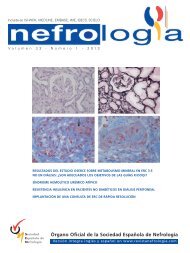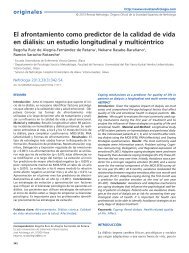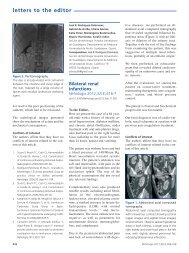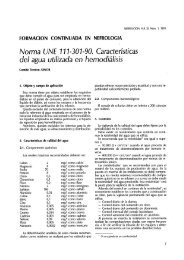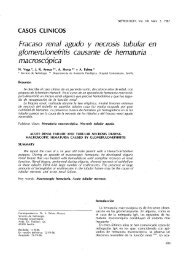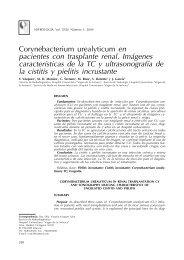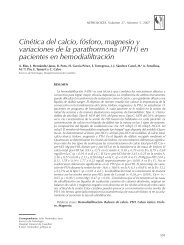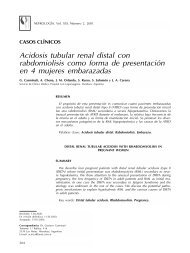PDF Número - NefrologÃa
PDF Número - NefrologÃa
PDF Número - NefrologÃa
Create successful ePaper yourself
Turn your PDF publications into a flip-book with our unique Google optimized e-Paper software.
http://www.revistanefrologia.com<br />
© 2012 Revista Nefrología. Órgano Oficial de la Sociedad Española de Nefrología<br />
originales<br />
Tratamiento con angioplastia y stent de la estenosis<br />
arterial del injerto renal<br />
Maitane del Pozo 1 , Jordi Martí 2 , Lluís Guirado 1 , Carme Facundo 1 , Cristina Canal 1 ,<br />
Pablo de la Torre 2 , José Ballarín 1 , Joan M. Díaz 1<br />
1<br />
Servicio de Nefrología. Fundació Puigvert. Barcelona<br />
2<br />
Servicio de Radiología. Fundació Puigvert. Barcelona<br />
Nefrologia 2012;32(4):455-8<br />
doi:10.3265/Nefrologia.pre2012.Jan.11080<br />
RESUMEN<br />
La estenosis arterial del injerto renal es una complicación<br />
que requiere, en ocasiones, un abordaje terapéutico con<br />
cirugía o angioplastia. El objetivo del presente estudio es<br />
analizar la evolución de 13 pacientes trasplantados<br />
renales con estenosis arterial del injerto tratados<br />
mediante angioplastia y colocación de stent. La sospecha<br />
clínica se fundamentó en un deterioro de función renal,<br />
acompañado de mal control de la presión arterial en<br />
algunos casos, con ecografía doppler compatible. Se<br />
realizó una arteriografía que confirmó el diagnóstico y<br />
en el mismo acto se realizó una angioplastia con<br />
colocación de stent. Se objetivó una mejoría progresiva<br />
de la función renal durante los 3 primeros meses que<br />
permaneció estable durante los dos primeros años. Por<br />
otro lado, mejoraron las cifras de presión arterial en los<br />
dos primeros años, manteniendo el mismo tratamiento<br />
antihipertensivo. En conclusión, la angioplastia con<br />
colocación de stent es un procedimiento efectivo y<br />
seguro en el tratamiento de la estenosis de la arteria del<br />
injerto renal.<br />
Palabras clave: Estenosis arterial. Trasplante renal.<br />
Angioplasty and stent treatment of transplant renal<br />
artery stenosis<br />
ABSTRACT<br />
Transplant renal artery stenosis is a major complication that<br />
requires a therapeutic approach involving surgery or<br />
angioplasty. The aim of this study was to analyse the evolution<br />
of renal transplant patients with renal allograft artery stenosis<br />
treated by angioplasty and stent placement. Thirteen patients<br />
were diagnosed with transplant renal artery stenosis. Clinical<br />
suspicion was based on deterioration of renal function and/or<br />
poorly controlled hypertension with compatible Doppler<br />
ultrasound findings. The diagnosis was confirmed by<br />
arteriography, performing an angioplasty with stent placement<br />
during the same operation. A progressive improvement in renal<br />
function was observed during the first 3 months after the<br />
angioplasty, and renal function then remained stable over 2<br />
years. In addition, blood pressure improved during the first 2<br />
years, and as a consequence there was no need to increase the<br />
average number of anti-hypertensive drugs administered (2.5<br />
drugs per patient). In conclusion, angioplasty with stent<br />
placement is a safe and effective procedure for the treatment of<br />
transplant renal artery stenosis.<br />
Keywords: Artery stenosis. Kidney transplantation.<br />
INTRODUCCIÓN<br />
La estenosis arterial del injerto renal constituye una importante<br />
complicación que produce hipertensión arterial, empeoramiento<br />
de la función renal e incluso pérdida del injerto renal<br />
y que tiene una incidencia, según los diferentes estudios,<br />
Correspondencia: Joan M. Díaz<br />
Servicio de Nefrología.<br />
Fundació Puigvert. Cartagena, 340. 08025 Barcelona.<br />
jdiaz@fundacio-puigvert.es<br />
que oscila entre 1 y 23% 1-3 . Habitualmente ocurre durante los<br />
dos primeros años postrasplante 1,2 . El diagnóstico de sospecha<br />
por imagen se realiza con la ecografía doppler, y la arteriografía<br />
renal continúa siendo el patrón oro para su diagnóstico<br />
e incluso para su tratamiento, ya que permite realizar una<br />
angioplastia y la colocación de stent en el mismo acto.<br />
No existen ensayos clínicos aleatorizados que establezcan la<br />
superioridad del tratamiento endovascular respecto al quirúrgico.<br />
Por otro lado, hay datos controvertidos acerca de los<br />
455



